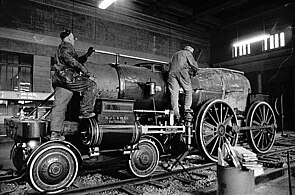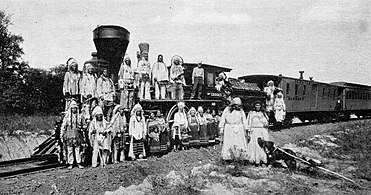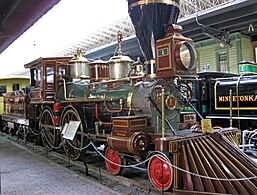
The Great Northern Railway was an American Class I railroad. Running from Saint Paul, Minnesota, to Seattle, Washington, it was the creation of 19th-century railroad entrepreneur James J. Hill and was developed from the Saint Paul & Pacific Railroad. The Great Northern's route was the northernmost transcontinental railroad route in the U.S.

A tender or coal-car is a special rail vehicle hauled by a steam locomotive containing its fuel and water. Steam locomotives consume large quantities of water compared to the quantity of fuel, so their tenders are necessary to keep them running over long distances. A locomotive that pulls a tender is called a tender locomotive. Locomotives that do not have tenders and carry all their fuel and water on board the locomotive itself are called tank locomotives or tank engines.

Under the Whyte notation for the classification of steam locomotives, 4-8-4 represents the wheel arrangement of four leading wheels on two axles, eight powered and coupled driving wheels on four axles and four trailing wheels on two axles. The type was first used by the Northern Pacific Railway, and initially named the Northern Pacific, but railfans and railroad employees have shortened the name since its introduction. It is most-commonly known as a Northern.

The Chicago, Burlington and Quincy Railroad was a railroad that operated in the Midwestern United States. Commonly referred to as the Burlington Route, the Burlington, or as the Q, it operated extensive trackage in the states of Colorado, Illinois, Iowa, Missouri, Nebraska, Wisconsin, Wyoming, and also in Texas through subsidiaries Colorado and Southern Railway, Fort Worth and Denver Railway, and Burlington-Rock Island Railroad. Its primary connections included Chicago, Minneapolis–Saint Paul, St. Louis, Kansas City, and Denver. Because of this extensive trackage in the midwest and mountain states, the railroad used the advertising slogans "Everywhere West", "Way of the Zephyrs", and "The Way West".
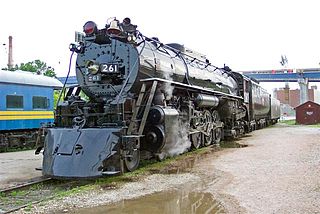
Milwaukee Road 261 is a class "S3" 4-8-4 "Northern" type steam locomotive built by the American Locomotive Company (ALCO) in Schenectady, New York in July 1944 for the Milwaukee Road.

Saint Paul Union Depot is a historic railroad station and intermodal transit hub in the Lowertown neighborhood of Saint Paul, Minnesota. It serves light rail, intercity rail, intercity bus, and local bus services.

The Louisville and Nashville Railroad, commonly called the L&N, was a Class I railroad that operated freight and passenger services in the southeast United States.
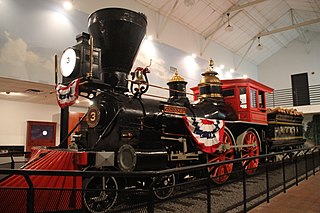
Western & Atlantic Railroad #3 General is a 4-4-0 "American" type steam locomotive built in 1855 by the Rogers, Ketchum & Grosvenor in Paterson, New Jersey for the Western & Atlantic Railroad, best known as the engine stolen by Union spies in the Great Locomotive Chase, an attempt to cripple the Confederate rail network during the American Civil War. Today, the locomotive is preserved at the Southern Museum of Civil War and Locomotive History in Kennesaw, Georgia, and is listed on the National Register of Historic Places.

Under the Whyte notation for the classification of steam locomotives, 2-4-0 represents the wheel arrangement of two leading wheels on one axle, four powered and coupled driving wheels on two axles and no trailing wheels. In most of North America it became known as a Porter.

A motive power depot (MPD) or locomotive depot, or traction maintenance depot (TMD), is where locomotives are usually housed, repaired and maintained. They were originally known as "running sheds", "engine sheds" or just "sheds". Facilities are provided for refuelling and the replenishing of water, lubricating oil and grease and, for steam engines, the disposal of ash. There are often workshops for day-to-day repairs and maintenance, but locomotive building and major overhauls are usually carried out at locomotive works.

The 400 was a named passenger train operated by the Chicago and North Western Railway between Chicago and Saint Paul, with a final stop in Minneapolis. The train took its name from the schedule of 400 miles between the cities in 400 minutes, and was also a nod to "The Four Hundred Club", a term coined by Ward McAllister to refer to the social elite of New York City in the late 19th century. It was an express train with limited stops between Chicago and the Twin Cities. The "400" ran from 1935 to 1963 on the Chicago to Twin Cities route. The C&NW later named their other passenger trains using the number "400".

A mechanical stoker is a mechanical system that feeds solid fuel like coal, coke or anthracite into the furnace of a steam boiler. They are common on steam locomotives after 1900 and are also used on ships and power stations. Known now as a spreader stoker they remain in use today especially in furnaces fueled by wood pellets or refuse.

The Eureka Springs & North Arkansas Railway is a for-profit passenger tourist railway established by the late Robert Dortch, Jr. and his wife Mary Jane in 1981 in Eureka Springs, Arkansas. The railway offers one-hour excursion tours, a catered luncheon train and a catered dinner train - each lasting a little more than one hour, from April through October. It operates along 2.5 miles (4.0 km) of restored track right-of-way formerly belonging to the defunct Arkansas & Ozarks Railway Co - the last incarnation of the North Arkansas Line.

The Minneapolis, St. Paul and Sault Ste. Marie Railroad (MStP&SSM) was a Class I railroad subsidiary of the Canadian Pacific Railway in the Midwestern United States. Commonly known since its opening in 1884 as the Soo Line after the phonetic spelling of Sault, it was merged with several other major CP subsidiaries on January 1, 1961, to form the Soo Line Railroad.
The Buffalo, Rochester, and Pittsburgh Railway was one of the more than ten thousand railroad companies founded in North America. It lasted much longer than most, serving communities from the shore of Lake Ontario to the center of western Pennsylvania.

Great Northern 2584 is a 4-8-4 "Northern" type steam locomotive built by the Baldwin Locomotive Works in Philadelphia, Pennsylvania in March 1930 for the Great Northern Railway (GN) as a member of the S-2 class.

The Great Northern S-2 was a class of 14 4-8-4 "Northern" type steam locomotives built by the Baldwin Locomotive Works in 1930 and operated by the Great Northern Railway until the late 1950s.
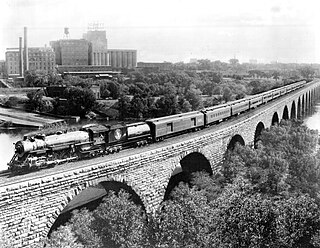
The Great Northern P-2 was a class of 28 4-8-2 "Mountain" type steam locomotives built by the Baldwin Locomotive Works in 1923 and operated by the Great Northern Railway until the late 1950s.
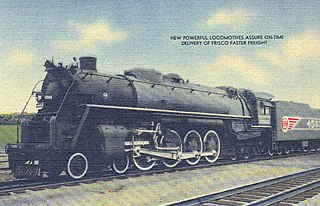
The St. Louis–San Francisco class 4500 was a class of 25 4-8-4 "Northern" type steam locomotives built by the Baldwin Locomotive Works between 1942-1943 and operated by the St. Louis–San Francisco Railway.

Spokane, Portland and Seattle Railway No. 539 is the only preserved example of the class O-3 2-8-2 "Mikado" steam locomotive. It was built by the American Locomotive Company in 1917 for the Northern Pacific Railway as engine No. 1762. It was sold to the Spokane, Portland and Seattle Railway and renumbered 539, in August 1944. It was reconfigured and converted to oil burning in January 1946. The locomotive was retired in 1957, and it was displayed in Esther Short Park, Washington, until 1997. That year, it was moved to Battle Ground for a potential restoration that never came to fruition. In 2007, it was acquired by the Grand Canyon Railway and moved to Williams, Arizona for an operational restoration that also never came to fruition. In 2019, No. 539 was purchased again by the Port of Kalama, who moved it back to Washington and put it on static display inside the Port's Interpretive Center that was constructed in 2014.





